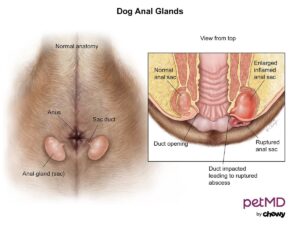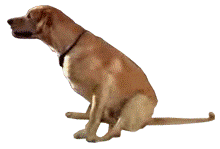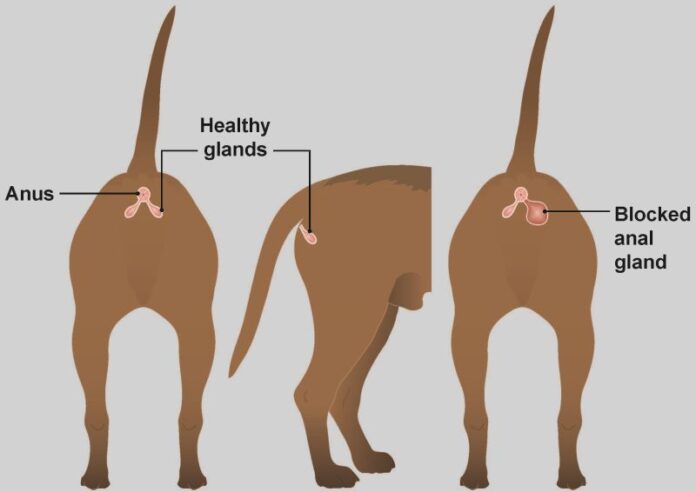The Importance of Anal Gland Expressions : What It Is and Why It’s Important
You know your dog marks his (or her – girls do it too!) territory with his pee, but did you know dog anal glands help him mark with his poop?
First of all, let’s be clear about what the dog anal glands or anal sacs are. Technically, the anal glands aren’t glands at all. In fact, they’re sacs. Each sac contains oil and sweat glands. They have small receptacles of foul-smelling liquid … a lot like skunks! Your dog has two anal glands, near the anal opening, at 4 o’clock and 8 o’clock. The glands can empty when your dog poops, or when he’s stressed.
When the glands express, they can create a very sudden, unpleasant change in your dog’s odor. So when dogs sniff each other’s butts, it’s like checking a human passport! Sniffing another dog’s rear tells your dog a lot about that other dog.
But there are times when things can go wrong with the anal glands.

The anal glands, technically called anal sacs, are two small pockets located at approximately 4 and 8 o’clock between the muscles just inside his anus. These sacs are lined with sebaceous (sweat) glands that secrete an oily, odorous fluid that collects within the sacs. When a dog defecates, the pressure of the stool and contracting muscles usually expels a small amount of this smelly material from two tiny ducts within the anal opening. This what gives dog stool that distinctive stinky odor. Anal sacs are similar to scent glands and can aid in communication with other dogs. Anal gland expression is the act of manually emptying the anal glands for the dog.
Dogs may also express their anal glands when they are afraid as a defense mechanism to distract an attacker. If your dog has been scared or startled by something, like getting chased by a neighbor’s dog or nearby fireworks, you may have noticed a foul smell afterward. That smell is courtesy of his anal glands being emptied.
Anal glands, or anal sacs, are two small pockets, each about the size of a small grape, located on the right and left side of a dog’s anus. Each gland connects to a small tube that secretes a very distinctive, foul-smelling fluid.
If your puppy is scooting across the carpet, ground or grass—sitting down and pulling itself forward while dragging its bottom—you might need to learn how to express its anal glands. Puppy scooting generally means the pooch’s bottom is irritated and/or itchy and that can be caused by many things including tapeworms, diarrhea fleas, or irritated anal glands
Under normal circumstances, when stool passes through the anus, it applies pressure to the glands and releases (expresses) the fluid.
Both male and female dogs, as well as cats and other animals, have anal glands. These glands are not essential to your dog’s health, and they can live without them if they need to be surgically removed for medical reasons.
Most dogs involuntarily express their anal glands. If a dog’s nutritional needs are being met with high-quality food, and they maintain a healthy weight and get plenty of exercise, they should not need to have their anal glands expressed. If your dog is not having an issue, there is nothing you need to do.
Check with your vet if you are wanting to do routine expression. Your vet may recommend leaving the anal glands alone if they are not causing a problem, or they may agree to routinely express them to avoid a medical issue.
Some dogs, however, require their glands to be manually expressed. If the consistency of your dog’s stool changes, their anal glands will not be naturally expressed. Then the liquid in the glands will thicken, making it harder to be able to express. If this happens, the glands can become irritated, inflamed, infected, and even impacted.
Once your dog starts to have issues with anal gland infections, impaction, or abscessation, it is usually best to have their glands expressed every 3-4 weeks to prevent the issue from happening again. Your dog’s anal glands can be expressed by your veterinarian, a veterinary technician, or even some dog groomers.
What is their function?
The anal sac secretion contains chemicals that act as territorial markers or ‘dog calling cards’. The secretions are similar to those produced by a skunk, which is used to repel enemies and alert other animals to their presence. Anal sac fluid is usually squeezed out by muscular contractions whenever the dog passes a bowel movement, providing a distinctive odor (or individual ‘scent signature’) to the feces. This is why dogs are so interested in smelling one another’s feces.
Your puppy has two anal glands located beneath the skin within the wall of the anus. The pea-size glands function like a skunk’s scent organs. Usually, the anal glands are expressed when the dog has a bowel movement, giving your pet’s bathroom deposits sort of an individual smelly fingerprint. Pets sniff each other’s bottoms as a way to communicate and “read” these scented name tags to identify each other.
Normal anal glands secrete a liquid or a creamy brownish/yellow substance that’s expressed whenever the puppy has a bowel movement. Glands may also be expressed when the pup is suddenly frightened or stressed and it contracts its anal sphincter—that’s the circular muscle that controls its rectum. You’ll notice a strong odor if this happens.
How to Express Your Dog’s Anal Glands
If your vet has agreed that your dog requires their anal glands to be expressed routinely, they might instruct you to do so at home if you are comfortable. Make sure that you are confident that your dog will not react aggressively.
If you see blood or pus around your dog’s anus, or if your dog seems very uncomfortable, do not attempt to express their anal glands at home. Instead, make an appointment with your veterinarian right away.
To express your dog’s anal glands at home, you need:
- Latex gloves
- Petroleum or a water-based lubricant
- Another person to help restrain your dog
Follow these steps to express your dog’s anal glands:
- If your dog is small, place them on a table or counter in front of you. If you have a large dog, you can kneel behind them.
- Have another person hold your dog by placing one arm underneath and around their neck, and the other arm around the rest of your dog’s body, hugging them close.
- Put on a pair of latex or similar gloves and lubricate your index finger with petroleum jelly or a water-based lubricant.
- Lift up your dog’s tail and gently insert your index finger into the rectum approximately 1 inch.
- Feel with your index finger and thumb for a firm pea- or marble-sized object at the 5 or 7 o’clock positions.
- When you have found one gland, place a paper towel between the dog’s anus and your hand and gently milk the gland’s contents outward by applying pressure on the farthest side of the gland and squeezing toward you. Do not use more pressure than you would feel comfortable applying if you were pressing on your eyes, for example.
- You should barely be able to feel the gland when it’s empty.
- Wipe the anal area clean.
- Repeat on the other side for the other gland.
Signs of Anal Gland Issues
The classic signature of anal gland problems is scooting. Your dog will drag his butt across the ground or floor, attempting to relieve the pressure and discomfort in his glands. But not all dogs with anal gland issues will scoot, and your dog may show other signs as well. Signs of an impacted or infected anal gland include:
- Scooting
- Licking at his anus persistently
- Strong odor
- Redness and/or swelling around the anus
- Straining to defecate
- Crying out when defecating
- Blood or pus in stool
- Blood, pus, or anal gland material draining down dog’s rear
- Blood, pus, or anal gland material left behind in places where your dog rests
- Straining to poop
- Crying when pooping
- Licking or chewing his butt
- Odor
- Discharge
- Chasing his tail
- Swelling and redness on his butt
- Aggression when you touch his tail or butt
NB-
Scooting

Scooting is the word to describe the action of a dog sitting down and dragging their bottom across the floor. While this behavior might seem amusing, it’s actually often a sign of discomfort, pain, or an itch. This action can be due to a simple reason, like having something stuck around the bottom. However, if consistent, this behavior can indicate a more serious issue with your dog’s health. A dog who frequently scoots might have blocked anal glands, an anal gland abscess, worms, or atopic dermatitis.
How do you know if your dog’s glands need emptying?
A dog with full or anal gland problems may scoot their bottom along the floor, scratch, bite or lick at their bottom or tail, have a fishy smell at the back end, seem in pain or depressed, object to anyone going near their back end.
- Drag their bottom along the floor (scoot)
- Try to scratch, lick or bite at their bottom (or even other areas of their body like their feet)
- Smell fishy from their bottom (or breath, if they have been licking their behind)
- Wag their tail less
- Seem depressed
- Object to their tail being lifted or handled
Big indications of anal gland issues are scooting and the fishy smell. The fishy smell occurs if the anal glands have gotten too full and they start leaking at times other than when the dog is toileting. Anal gland fluid has a very potent rotten fish smell. Full anal glands can leak when the dog is at rest, sleeping or is picked up.
There is a common misconception that a dog will drag their bottom along the floor when they have worms. In reality, it is most likely to be because of full anal sacs. Your dog is trying to release the fluid and relieve the discomfort. The strong fishy smell is coming from anal glands that are full but leaking some fluid. You may smell it on your soft furnishings or actually coming from your dogs bottom.
If you notice these things it could be that your dog has an anal sac issue and/or your dog’s anal glands are not emptying correctly on their own. If it just happens occasionally then that is quite normal and no cause for concern. Your dog only needs help if the problem becomes frequent.
What Causes Anal Gland Problems?
A variety of things can contribute to anal gland issues. Some common causes and contributing factors include:
- Diarrhea (soft stools don’t properly express the anal glands during defecation)
- Constipation (no stool = no anal gland expression)
- Obesity
- Chronic skin infections (bacterial or yeast)
- Allergies (environmental and food-related)
- Mites
- Hypothyroidism
These are some factors that can cause dogs to develop anal gland problems:
- Obesity
- Hypothyroidism
- Low-fiber diet
- Diarrhea
- Gastrointestinal disease
- Inflammatory bowel disease
- Food allergies
- Intestinal parasites
- Tumors (less common)
Certain types of small dogs, such as Chihuahas, beagles, miniature poodles and cocker spaniels, are also more likely to have anal gland problems.
Less commonly, anal gland impaction can be caused by a tumor or a congenital defect that prevents normal drainage.
Small breed dogs are somewhat more likely to have issues with their anal glands, but these problems can beset dogs of all sizes.
How to treat anal gland problems in dogs
A quick guide on how to empty dogs’ anal glands yourself:
- Wear latex gloves and have a warm cloth to hand.
- Find the anal glands at 4 and 8 o’clock when looking at the anus.
- Apply firm but gentle pressure to the glands under the skin and move upwards and back towards the anus.
- Hold the cloth over the anus to prevent the smelly fluid squirting everywhere.
- Wipe the dog clean and give them a reward.
If you see any signs of anal gland problems for the first time, have your dog checked over by a vet to identify the particular cause, and decide the treatment and management needed. If there is any sign of blood, pus or lots of pain, go to the vet as soon as possible. Infections will likely require antibiotics and may need flushing clean.
Impactions can be relieved by manually expressing the glands. If the impaction is severe or infected, a vet must do this as it can be very painful and may need sedation. If the underlying cause means that the dog will suffer from repeated blockages, the glands will need regularly expressing. Some experts say dog anal gland cleaning is an expert job, but your vet or groomer may show you how to do this at home to avoid stressing your dog with repeated visits.
If your dog is not showing any signs of problems, there is no need to express the glands, and it may do more harm than good if done too often.
One of the most common causes is soft stools. This can result from feeding a poor quality diet, or one with ingredients to which your dog is allergic or intolerant. A frequent offender for dogs is wheat. Switching to a high quality, low processed and nutritious food can help keep your dog’s stomach happy and healthy.
Are there any preventive measures to avoid anal gland issues in dogs?
Dog parents can take a few preventative measures to try to help avoid anal gland issues in their dogs.
- Make sure your dog is getting plenty of fiber: Fiber helps to keep stool firm and bulky, making it more likely that your dog will express their anal glands naturally,
- Avoid feeding table scraps: Inappropriate treats can lead to loose stool, which can make it more difficult for your dog to express their anal glands.
- Keep your dog at a healthy weight: Overweight dogsare more likely to have anal gland issues. Make sure your dog is getting plenty of exercise and gets proper nutrition.
- Stay on top of it: Anal gland impaction can progress to an anal gland infection. If your dog is showing signs of anal gland problems, take them to a vet. If needed, make expressing your dog’s anal glands a part of their grooming schedule.
Prevention
Prevention is always better, so it’s important to ensure that your pup has a healthy diet.
Just like humans, dogs are healthiest when they aren’t overweight and have regular exercise. Make sure your pup has plenty of drinking water as dehydration can also lead to constipation
Ensure that your dog is getting enough fibre in their diet. There are many commercially available fibre supplements that you can add to your dogs meals, or you can try high fibre veggies to their meals, such as:
- Wheatgerm
- Flaxseed
- Carrots
- Broccoli
- Kale
- Kelp
- Pumpkin
- Apples
Compiled & Shared by- Team, LITD (Livestock Institute of Training & Development)
Image-Courtesy-Google
Reference-On Request


